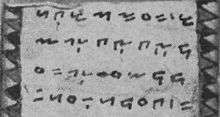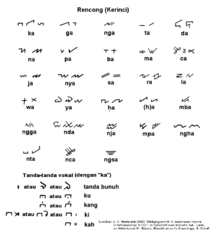Rencong alphabet
| Rencong | |
|---|---|
| Type | |
| Languages | Besemah, Lampung, Malay, Rejang, Serawai, and others |
Time period | c. 13th–now |
Parent systems | |
Sister systems |
Balinese Batak Baybayin Kulitan Buhid Hanunó'o Javanese Lontara Old Sundanese Rejang Tagbanwa |

]

Rencong, or "Rentjong," is a general term used to refer to any native writing systems found in Malay Peninsula, central and south Sumatra, including Kerinci, Bengkulu, Palembang and Lampung.[1] These scripts lasted until the 18th century, when the Dutch colonised Indonesia. These scripts were used to write manuscripts in native languages and in Malay, such as the Tanjung Tanah Code of Law. The Malay writing was gradually replaced by the Jawi script, a localized version of the Arabic script.
Rencong scripts were often written on tree bark, bamboo, horns and palmyra-palm leaves. Many of the Rencong scripts are also known as "Surat Ulu," or "upriver scripts," given their prevalence away from a coastline.
The term "Rencong" is often confused with "Rejang," which refers to a specific set of related scripts that were used to write various dialects of the Rejang language and for writing Malay in the region.
This map below shows the distribution of various Rencong scripts in South Sumatra:

See also
| Wikimedia Commons has media related to Rencong alphabet. |
- Rejang script
- Kerinci script
- Lampung script
- Palembang script
- List of languages of Indonesia